Products
-

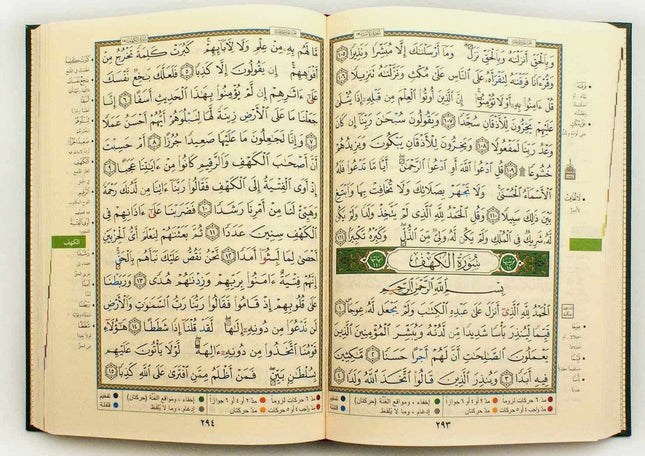
Tajweed Quran with Case- Arabic only- HAFS - Large (17x24cm)
This Tajweed Qur’an follows the Hafs narration. All our Tajweed Qur’an editions, including this one, feature the following: Colour-Coded Letters: Each colour represents a specific Tajweed rule — an effective and simple way to learn and apply correct pronunciation. Clear, Readable Script: Extra spacing between words makes reading and recitation smoother and easier. Guided Stopping Points: Extended spaces are placed at permissible pause marks to help readers avoid stopping at incorrect places. Comprehensive Indexes: Includes a Surah Colour Index and a Subject Index for quick reference. Detailed Tajweed Guide: Clear explanations of the rules with helpful illustrations to support learning.
£19.99
-
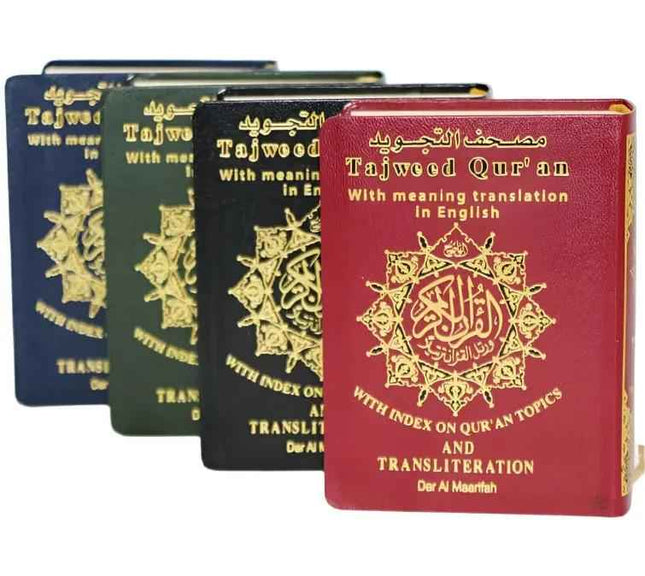
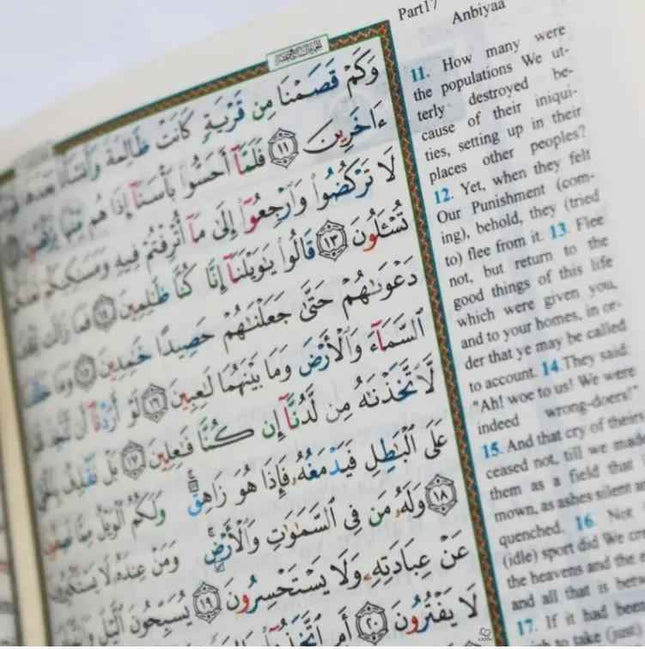
Tajweed Quran with English Translation & Transliteration - POCKET Size (8x12cm)
ALLAH (SWT) ordered us in his holy book to recite the Quran with tajweed. "Recite the Quran modulatingly." the system of tajwid serves as a guide to improve the style of Quranic recitation. It was in this way that the holy Quran was revealed to prophet Mohammed صلی الله علیه وآلهِ وسلم and also the manner in which he recited it. Therefore, the reader of the holy Quran longs to achieve the promise of Prophet Mohammed صلی الله علیه وآلهِ وسلم: "whoever recites the Quran correctly and proficiently will be with the bountiful dutiful writers (the angels of the preserved tablet (Al lauh Al Mahfuz). Based on a practical understanding of phonology, we have color-coded the place of some letters to facilitate the correct recitation of the holy Quran. This had enabled us to classify these letters into three possible categories, enhancing the reader's knowledge and remembrance of tajweed rules. 1. The letters which requires expanded vocalisation. We used red colour to highlight these. 2. The letters which is nasalized. These letters are green in colour. 3. The dark blue colour indicates the emphatic of the letter (R), the blue colour indicates the unrest letters-echoing sound- (qualquala) 4 While the letters which are written but are not pronounced. These letters are gray in colour.. The reader will get used to reciting the Quran by using colour just as he got used to stopping at red lights and passing through green lights. By engaging I this sublime act, the reader will find himself applying 24 rules of tajweed with ease and precision while his mind is left free to contemplate and understand the meaning of Holy Quran.
£11.99
-
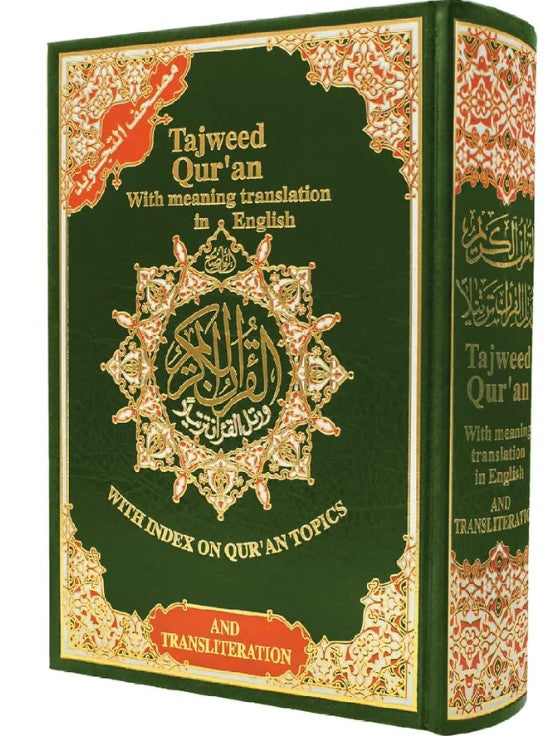
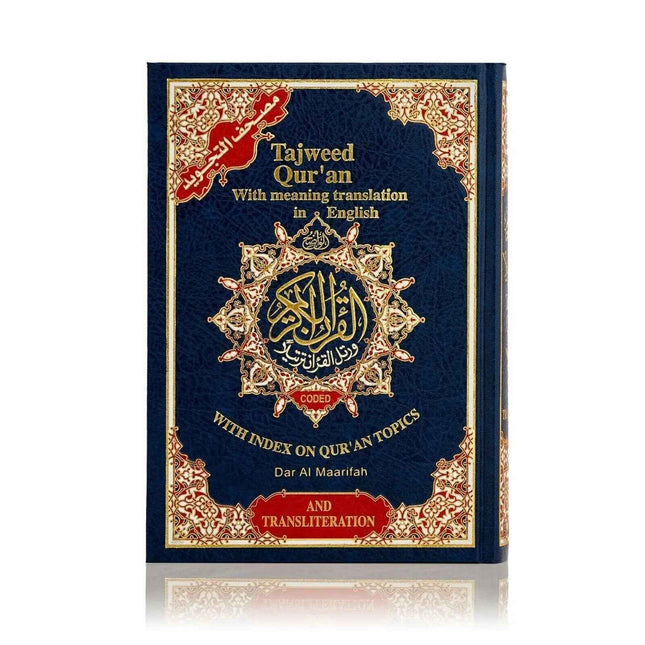
مصحف التجويد مع الترجمة باللغة الإنجليزية والحروف الصوتية
عنوان الكتاب: تجويد القرآن الكريم مع ترجمة معانيه باللغة الإنجليزية وبالترجمة الحرفية المترجم: عبدالله يوسف علي الناشر: دار المعرفة سنة النشر 2003 الصفحات: 604 الحجم سم: 25x17 سم الخط : الخط العثماني أمرنا الله سبحانه وتعالى في كتابه الكريم بتلاوة القرآن بالتجويد. "رتل القرآن تحويراً." نظام التجويد بمثابة دليل لتحسين أسلوب تلاوة القرآن. وبهذه الطريقة نزل القرآن الكريم على النبي محمد صلى الله عليه وسلم، وكذلك الطريقة التي قرأ بها. ولذلك فإن قارئ القرآن الكريم يشتاق إلى تحقيق وعد النبي محمد صلى الله عليه وسلم: (من قرأ القرآن متقنا كان مع البركات الكاتبين (ملائكة اللوح المحفوظ)). انطلاقاً من الفهم العملي لعلم الأصوات، قمنا بترميز أماكن بعض الحروف بالألوان لتسهيل التلاوة الصحيحة للقرآن الكريم، مما مكننا من تصنيف هذه الحروف ضمن 3 فئات ممكنة لتعزيز معرفة القارئ واستذكاره للتجويد. القواعد. 1. الحروف التي تتطلب نطقا موسعا. استخدمنا اللون الأحمر لتمييز هذه الحروف. 2. الحروف الأنفية. هذه الحروف لونها أخضر. 3. اللون الأزرق الداكن يدل على توكيد حرف (ر) فاللون الأزرق يدل على الحروف المضطربة - صدى الصوت - ( الكوالكالا ) 4. أما الحروف التي تكتب ولا تنطق فهذه الحروف رمادية اللون وسيعتاد القارئ على قراءة القرآن باستخدام اللون كما هو الحال مع اعتاد على التوقف عند الأضواء الحمراء والمرور عبر الأضواء الخضراء. ومن خلال الانخراط في هذا العمل الجليل، سيجد القارئ نفسه يطبق 24 قاعدة من قواعد التجويد بكل سهولة ودقة، بينما يترك عقله حرًا للتأمل وفهم معاني القرآن الكريم.
£45.00 £39.99
-

Tajweed Rules of the Quran (3 Parts Set)- أحكام تجويد القران
This is a complete set of 3 books. Book 1 – This is a guide for studying tajweed. The student who uses this bookis expected to have a basic grasp of Arabic before starting thiscourse. The student should know all the Arabic letters and vowels andbe able to read at an elementary level. This book is either for anEnglish speaking student studying the Qura’an in an Arabicenvironment, but needing explanation of the Arabic terms in English,or a student studying the explanations of tajweed in English, butlearning the basic concepts in Arabic so they may integrate into theArabic terms and definitions throughout the book, since the science oftajweed is an Arabic science. This book explains the articulation points of the Arabic letters, therules of noon saakinah, meem saakinah, and lam saakinah. It explainsall of the different lengthenings (mudood), and how voweled, andnon-voweled letters are formed. The qalaqah mechanism is explained inthe last chapter. Terms are introduced in Arabic, and the translatedinto English. Explanations are done in English, but with integrationof Arabic terms, as they are learned. A student of the Qur’an cannot except to learn tajweed simply bystudying this book. The learning of proper Qur’anic recitation canonly be done by listening to a qualified Qur’an teacher recite, thenreciting to them and receiving corrections from the teacher. Book 2 – By Allah’s grace, this is the second part of what shall be, insha’Allah, a three part series on the rules of tajweed of the Qur’an, forthe recitation of Hafs from ‘Aasim by the way of Ash-Shaaibiyyah. Thebook is intended to be a guide for non-Arabs with a good grasp inEnglish in studying tajweed. This book explains the concept of the accent(an-nabr) in therecitation of the Glorious Qur’an and the conditions of its use, italso defines and explains the important chapter on the characteristicsof the letters, velarization and attenuation (tafkheem and tarqeeq)are covered in the part, as well as the concept of the two alike, thetwo similar, the two close, and the two far and the rules for idghaamterms is made in this book to assist the student in understanding thelast chapter, that of the connecting hamzah(hamzah al-wasl). The explanations of the different subjects are in English and theArabic terms are translated. This is to assist the student inunderstanding and encourage them to learn the Arabic definitions andterms. This book should facilitate non-Arabs studying tajweed whetherthey are in a classroom with explanations taught in Arabic or inEnglish. This book cannot replace the importance of reciting to and beingcorrected by a trained teacher of tajweed, instead it is a guide andan aid in understanding the concepts of tajweed, the application canonly be refined by recitation and correction. Book 3 – Al-hamdu lillah, this is the third and final part of a three part series in English on the rules of tajweed of the Qur’an for the recitation of Hafs from ‘Aasim by the way of Ash-Shaatibiyyah. These books are meant as a guide for non-Arabs with a good grasp of English for studying tajweed of the Glorious Qur’an. This final book explains the stop and start when reading the Glorious Qur’an, and gives details as to what kind of stop is allowed, what kind preferred, and what kind of stop is forbidden. Stopping on the ends of words with strong endings (consonants)and rules for what is allowed on the last letter of the word is described, including and Stopping on the ends of words with weak endings (words ending in the alif, ya’ or wow) and different rules and explanations for these type of words is clarified. One important aspect of Qur’an recitation is knowing and understanding which word combinations are written together and which separately in different parts of the Qur’an as well as in which places of the Qur’an are some words are written with the female and in which places they are written with the This part lays out the different places in the Qu’ran these occurrences take place, so the reader knows how he/she can stop on these words. The words that are read in a special way, or have two allowed ways for the reading of Hafs from ‘Aasim by the way of Ash-Shaatibiyyah are detailed in this book. The history of the writing of the Glorious Qur’an (– ) and the general rules for the writing of the Qur’an are laid out in the last chapter of this part. This last part of the three parts on tajweed is for students who have studied and mastered the other two parts, or have studied everything covered in the first two parts. The explanations of the different subjects are in English, and the Arabic terms are translated. The goal is always to assist the student in understanding and to encourage them to learn the Arabic terms and definitions. The three parts of this series on tajweed rules of the Glorious Qur’an should facilitate non-Arabic speaking students of the Qur’an whether they are in a classroom with an Arabic medium for teaching or English. With this third part completed, insha’ Allah the non-Arab English speaking student of the Qur’an will find a complete curriculum and explanation of the tajweed rules for the recitation of Hafs ‘an ‘Aasim from the way of Ash-Shatibiyyah in any classroom or study situation that he/she may find themselves in. These three parts are only guidance; the real goal is reciting and applying all the different rules correction which can only be done by reciting to and being corrected by a qualified teacher of the Qur’an
£25.00 £21.99
-


Tajweed Rules of the Quran Part 1- أحكام تجويد القران
This book explains the articulation points of the Arabic letters, the rules of noon saakinah, meem saakinah, and lam saakinah. It explains all of the different lengthenings(mudood) and how voweled/non-voweled letters are formed. The qalqalah mechanism is explained in the last chapter. Terms are introduced in Arabic and then translated into English. Explanations are done in English but with integration of the Arabic terms as they are learned.
£7.50
-


Tajweed Rules of the Quran part Two- أحكام تجويد القران
This is the second part of what shall be, insha' Allah, a three part series on the rules of tajweed of the Qur'an, for the recitation of Hafs from 'Aasim by the way of Ash-Shaatibiyyah. The book is intended to be a guide for non-Arabs with a good grasp in English in studying tajweed. This book explains the concept of the accent (an-nabr) in the recitation of the Glorious Qur'an and the conditions of its use, it also defines and explains the important chapter on the characteristics of the letters, velarization and attenuation (tafkheem and tarqeeq) are covered in this part, as well as the concept of the two alike, the two similar, the two close, and the two far and the rules for idghaam and ith-haar in these different relationships. A brief introductory to grammar terms is made in this book to assist the student in understanding the last chapter, that of the connecting hamzah (hamzah al-wasl). The explanations of the different subjects are in English, and the Arabic terms are translated. This is to assist the student in understanding and encourage them to learn the Arabic definitions and terms. This book should facilitate non-Arabs studying tajweed whether they are in a classroom with explanations taught in Arabic or in English. This book cannot replace the importance of reciting to and being corrected by a trained teacher of tajweed, instead it is a guide and an aid in understanding the concepts of tajweed, the application can only be refined by recitation and correction
£7.50
-


Tajweed Rules of the Quran Part-3 أحكام تجويد القران
This is the third and final part of a three part series in English on the rules of tajweed the Qur'an for the recitation of Hafs from 'Aasim by the way of Ash-Shaatibiyyah. These books are meant as a guide for non-Arabs with a good grasp of English for studying tajweed of the Glorious Qur'an. This final book explains the stop and start when reading the Glorious Qur'an, and gives details as to what kind of stop is allowed, what kind is preferred, and what kind of stop is forbidden. Stopping on the ends of words with strong endings (consonants) and rules for what is allowed on the last letter of the word is described, including ar-room (الروم) and al-ishmaam (الإشمام). Stopping on the ends of words with weak endings (words ending in the alif, ya' or wow) and different rules and explanations for these type of words is clarified. One important aspect of Qur'an recitation is knowing and understanding which word combinations are written together and which separately in different parts of the Qur'an as well as in which places of the Qur'an are some words are written the female haa (هاء), and in which places they are written with the taa (تاء). This part lays out the different places in the Qur’an these occurrences take place, so the reader knows how he/she can stop on these words. The words that are read in a special way, or have two allowed ways for the reading of Hafs from 'Aasim by the way of Ash-Shaatibiyyah are detailed in this book. The history of the writing of the Glorious Qur'an (رسم) and the general rules for the writing of the Qur'an are laid out in the last chapter of this part. This last part of the three parts on tajweed is for students who have studied and mastered the other two parts, or have studied everything covered in the first two parts. The explanations of the different subjects are in English, and the Arabic terms are translated. The goal is always to assist the students in understanding and to encourage them to learn the Arabic terms and definitions. The three parts of this series on tajweed rules of the Glorious Qur'an should facilitate non-Arabic speaking students of the Qur’an whether they are in a classroom with an Arabic medium for teaching or English. With this third part completed, insha' Allah the non-Arab English speaking student of the Qur'an will find a complete curriculum and explanation of the tajweed rules for the recitation of Hafs 'an 'Aasim from the way of Ash-Shatibiyyah in any classroom or study situation that he/she may find themselves in. These three parts are only guidance; the real goal is reciting and applying all the different rules correction which can only be done by reciting to and being corrected by a qualified teacher of the Qur’an.
£8.50
-
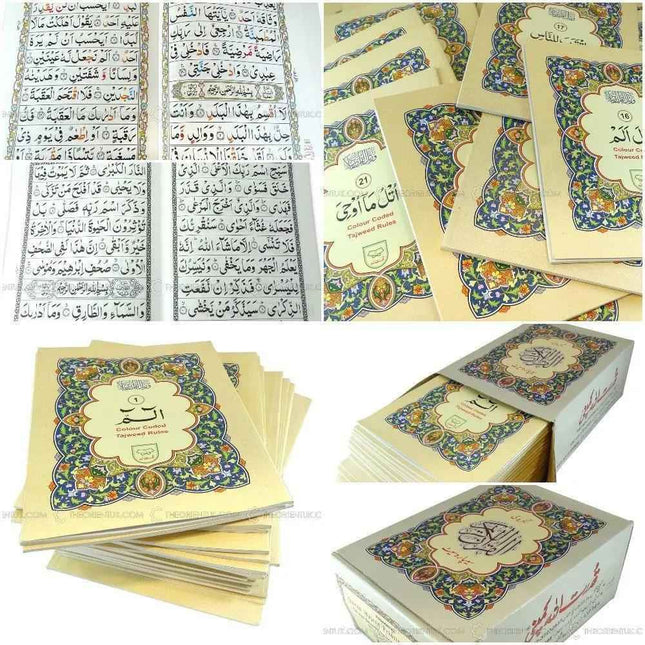

Tajweedi 9 Line Full 30 Para/Juz Set- 30 Separate Siparah With Collapsible box Set
his 9 Line Colour Coded tajweed Rules 30 Parts of Quran (Siparah Set) is checked by certified Quran Proofreaders and found no errors. This Parah Set is presented by Taj Company for Muslims all over the world. This Parah Set Comes with a nice Collapsible box beautiful design and with perfect finishing. The size of this 9 line Siparah Set is good for reading at home. Plus, the quality of paper (Art / Glossy)is very high to facilitate the correct recitation of The Holy Quran.
£39.99
-
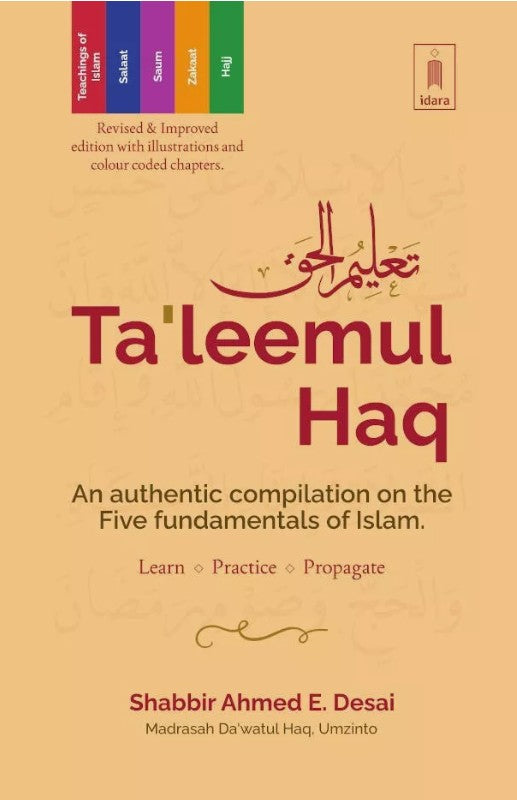

Taleemul Haq: Coloured Revised & Improved Edition with Illustrations (PB)
Providing the youth of the Muslim ummah with sound religious education and training is a vital responsibility. To fulfil this need, Shabbir Ahmed E. Desai Soofi has compiled a highly beneficial and authentic work in both Urdu and English titled Taleemul Haq. This book presents the essential beliefs, practices, character, and acts of devotion in a clear and simple style. It covers fundamental rulings on Wudhu, Salah, Fasting, and more—making it an excellent guide for children to learn and apply in their daily lives. If studied, understood, and practiced, Taleemul Haq will, Insha’Allah, help mould young lives according to the Sunnah and protect them from ignorance and misguidance. This new 2022 edition has been revised and improved, featuring coloured content, illustrations, and colour-coded chapters for easier learning.
£5.99
-
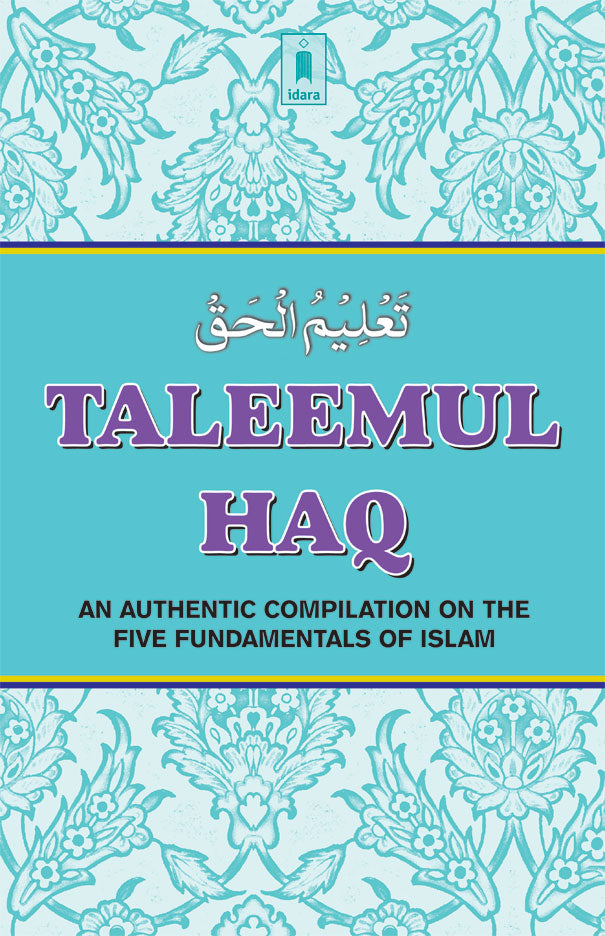
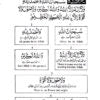
Taleemul Haq: English An authentic compilation on five Fundamentals of Islam
To equip the youths of the Muslim ummah with religious education and training is an important duty. The author Shabbir Ahmed E. Desai Soofi has compiled a very beneficial and authentic publication in Urdu and English called “Taleemul Haq” to educate the Muslim children in their beliefs and practices. In it, the basic beliefs, practices, character, and devotional aspects (of Muslim life) have been explained in simple language with the ruling on Wudhu, Namaz, Fasting, etc. If children read, understand, and practice accordingly, then Insha Allah their lives can be molded according to the sunnah and they will be safe from ignorance and being led astray.
£3.99
-

Taqwiyat-ul-Iman Strengthening of the Faith | Islamic Book
Taqwiyat-ul-Iman (Strengthening of the Faith)Author: Shah Isma’il DehlviPublisher: DarussalamFormat: HardbackPages: Approx. 120ISBN: 978-9960892108Language: EnglishWeight: Approx. 200g Description:Taqwiyat-ul-Iman is a powerful and thought-provoking book written by the renowned Islamic scholar Shah Isma’il Shaheed. Originally penned in Urdu in the 19th century, this book addresses issues of Tawheed (the Oneness of Allah) and purifying Islamic belief from superstitions and innovations (bid’ah). It serves as a wake-up call for Muslims to return to the authentic teachings of the Qur’an and Sunnah, free from cultural and un-Islamic influences. This English translation makes it accessible for modern readers who seek a deeper understanding of Islamic monotheism and the fundamentals of faith. Note for International Buyers:We offer combined shipping for overseas orders. Please message us with the items you're interested in, and we will arrange a custom listing with discounted shipping.
£6.99
-


Tawassul - Seeking A Means of Nearness To Allaah- Its Types and Its Rulings By Shaykh Nasir Uddin al-Albani
A detailed and authoritative discussion on the important subject of tawassul (or seeking a means of nearness to Allaah). Although this topic is central to our belief there is very little authentic information available in the English language. In his usual scholarly manner the Sheikh very convincingly clarifies the issue and identifies the types of tawassul that are approved of in the Qur’an and Sunnah. The Sheikh also goes to great lenghths to show the falsity of the invented forms of tawassul, refuting the doubts that are raised one by one - in an extremely convincing manner.
£5.50



























